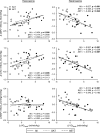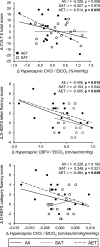One-year aerobic exercise altered cerebral vasomotor reactivity in mild cognitive impairment
- PMID: 34013755
- PMCID: PMC8325610
- DOI: 10.1152/japplphysiol.00158.2021
One-year aerobic exercise altered cerebral vasomotor reactivity in mild cognitive impairment
Abstract
The purpose of this study was to test the hypothesis that changes in cerebral vasomotor reactivity (CVMR) after 1-yr aerobic exercise training (AET) are associated with cognitive performances in individuals with amnestic mild cognitive impairment (MCI). Seventy sedentary patients with amnestic MCI were randomized to 1-yr moderate-to-vigorous intensity AET or stretching and toning (SAT) interventions. Cerebral blood flow velocity (CBFV) with transcranial Doppler, mean arterial pressure (MAP) with finapres plethysmograph, and EtCO2 with capnography were measured during hyperventilation (hypocapnia) and a modified rebreathing protocol (hypercapnia) to assess CVMR. Cerebrovascular conductance index (CVCi) was calculated by CBFV/MAP, and CVMR by ΔCBFV/ΔEtCO2 and ΔCVCi/ΔEtCO2. Episodic memory and executive function were assessed using standard neuropsychological tests (CVLT-II and D-KEFS). Cardiorespiratory fitness was assessed by peak oxygen uptake (V̇o2peak). A total of 37 patients (19 in SAT and 18 in AET) completed 1-yr interventions and CVMR assessments. AET improved V̇o2peak, increased hypocapnic CVMR, but decreased hypercapnic CVMR. The effects of AET on cognitive performance were minimal when compared with SAT. Across both groups, there was a negative correlation between changes in hypocapnic and hypercapnic CVMRs in CBFV% and CVCi% (r = -0.741, r = -0.725, P < 0.001). Attenuated hypercapnic CVMR, but not increased hypocapnic CVMR, was associated with improved cognitive test scores in the AET group. In conclusion, 1-yr AET increased hypocapnic CVMR and attenuated hypercapnic CVMR which is associated cognitive performance in patients with amnestic MCI.NEW & NOTEWORTHY One-year moderate-to-vigorous intensity aerobic exercise training (AET) improved cardiorespiratory fitness (V̇o2peak), increased hypocapnic cerebral vasomotor reactivity (CVMR), whereas it decreased hypercapnic CVMR when compared with stretching and toning in patients with amnestic mild cognitive impairment (MCI). Furthermore, changes in hypercapnic CVMR with AET were correlated with improved memory and executive function. These findings indicate that AET has an impact on cerebrovascular function which may benefit cognitive performance in older adults who have high risk of Alzheimer's disease.
Keywords: aerobic exercise training; cerebral vasomotor reactivity; cognitive function; mild cognitive impairment; transcranial Doppler.
Conflict of interest statement
No conflicts of interest, financial or otherwise, are declared by the authors.
Figures



Similar articles
-
Cerebral Vasomotor Reactivity in Amnestic Mild Cognitive Impairment.J Alzheimers Dis. 2020;77(1):191-202. doi: 10.3233/JAD-200194. J Alzheimers Dis. 2020. PMID: 32716360
-
One-Year Aerobic Exercise Reduced Carotid Arterial Stiffness and Increased Cerebral Blood Flow in Amnestic Mild Cognitive Impairment.J Alzheimers Dis. 2021;80(2):841-853. doi: 10.3233/JAD-201456. J Alzheimers Dis. 2021. PMID: 33579857 Clinical Trial.
-
Cerebral vasomotor reactivity during hypo- and hypercapnia across the adult lifespan.J Cereb Blood Flow Metab. 2020 Mar;40(3):600-610. doi: 10.1177/0271678X19828327. Epub 2019 Feb 15. J Cereb Blood Flow Metab. 2020. PMID: 30764704 Free PMC article. Clinical Trial.
-
T and B cell subsets differentially correlate with amyloid deposition and neurocognitive function in patients with amnestic mild cognitive impairment after one year of physical activity.Exerc Immunol Rev. 2019;25:34-49. Exerc Immunol Rev. 2019. PMID: 30785868 Free PMC article. Review.
-
Effects of cardiorespiratory fitness and exercise training on cerebrovascular blood flow and reactivity: a systematic review with meta-analyses.Am J Physiol Heart Circ Physiol. 2021 Jul 1;321(1):H59-H76. doi: 10.1152/ajpheart.00880.2020. Epub 2021 May 21. Am J Physiol Heart Circ Physiol. 2021. PMID: 34018848
Cited by
-
Aerobic exercise training reduces cerebrovascular impedance in older adults: a 1-year randomized controlled trial.J Appl Physiol (1985). 2022 Oct 1;133(4):902-912. doi: 10.1152/japplphysiol.00241.2022. Epub 2022 Sep 15. J Appl Physiol (1985). 2022. PMID: 36107990 Free PMC article. Clinical Trial.
-
Advances in exercise-induced vascular adaptation: mechanisms, models, and methods.Front Bioeng Biotechnol. 2024 Feb 22;12:1370234. doi: 10.3389/fbioe.2024.1370234. eCollection 2024. Front Bioeng Biotechnol. 2024. PMID: 38456010 Free PMC article. Review.
-
Physical activity and perceived barriers in individuals with moderate-to-severe traumatic brain injury.PM R. 2023 Jun;15(6):705-714. doi: 10.1002/pmrj.12854. Epub 2022 Jul 15. PM R. 2023. PMID: 35596121 Free PMC article.
-
Arterial Aging and Cerebrovascular Function: Impact of Aerobic Exercise Training in Older Adults.Aging Dis. 2024 Aug 1;15(4):1672-1687. doi: 10.14336/AD.2023.1109-1. Aging Dis. 2024. PMID: 38270114 Free PMC article. Review.
-
A single 1,500 m freestyle at maximal speed decreases cognitive function in athletes.Front Psychol. 2023 Dec 6;14:1283585. doi: 10.3389/fpsyg.2023.1283585. eCollection 2023. Front Psychol. 2023. PMID: 38125859 Free PMC article.
References
-
- Iturria-Medina Y, Sotero RC, Toussaint PJ, Mateos-Perez JM, Evans AC, Alzheimer's Disease Neuroimaging I; Alzheimer’s Disease Neuroimaging Initiative. Early role of vascular dysregulation on late-onset Alzheimer's disease based on multifactorial data-driven analysis. Nat Commun 7: 11934, 2016. doi:10.1038/ncomms11934. - DOI - PMC - PubMed
Publication types
MeSH terms
Grants and funding
LinkOut - more resources
Full Text Sources
Other Literature Sources
Medical
Research Materials

